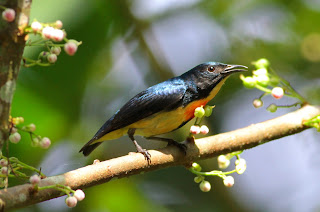Drongo Cuckoo
Aptly called "drongo" cuckoo I
think because of the similarity of its same shape & slender tail. Slightly
larger than a pigeon. Can compare with a Bronze Drongo later. The glossy bluish
feathers are almost the same. Only difference is in the shape of the beak and
head features. You wonder it a mixed breed..........
They are very approachable and not easily spooked unless you move exaggerately. They are curious bugger too and will come 20-25 feet. near u which I did encounter the specie at ISI Rimba site in Kemensah last week.
They are very approachable and not easily spooked unless you move exaggerately. They are curious bugger too and will come 20-25 feet. near u which I did encounter the specie at ISI Rimba site in Kemensah last week.
 |
| Capture at Langkap-Ipoh Talang Nov2024 |


















































